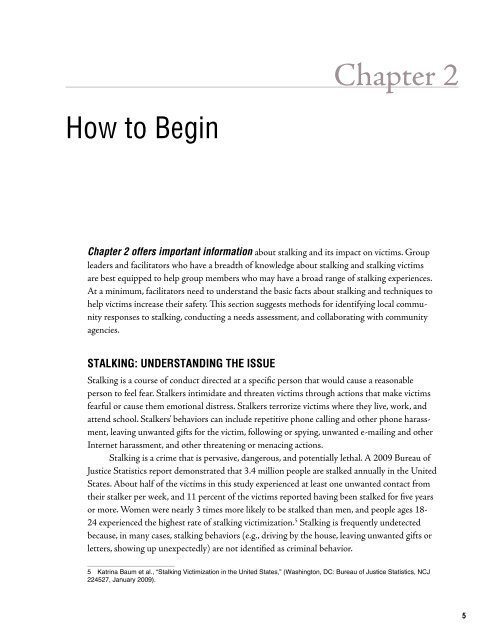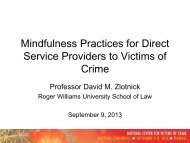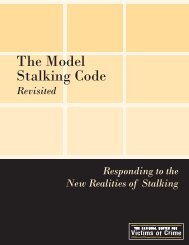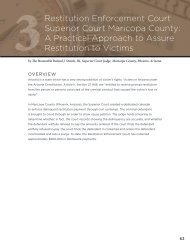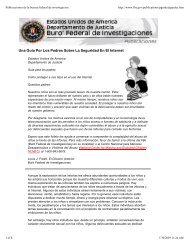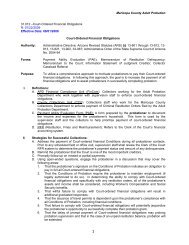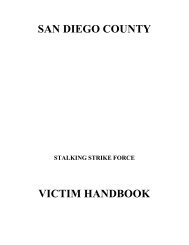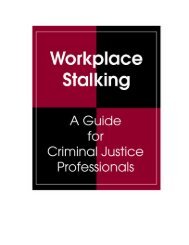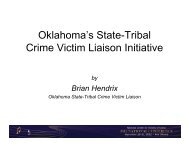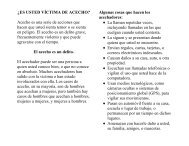How to Start and Facilitate a Support Group for Victims of Stalking
How to Start and Facilitate a Support Group for Victims of Stalking
How to Start and Facilitate a Support Group for Victims of Stalking
- No tags were found...
Create successful ePaper yourself
Turn your PDF publications into a flip-book with our unique Google optimized e-Paper software.
Chapter 2<strong>How</strong> <strong>to</strong> BeginChapter 2 <strong>of</strong>fers important in<strong>for</strong>mation about stalking <strong>and</strong> its impact on victims. <strong>Group</strong>leaders <strong>and</strong> facilita<strong>to</strong>rs who have a breadth <strong>of</strong> knowledge about stalking <strong>and</strong> stalking victimsare best equipped <strong>to</strong> help group members who may have a broad range <strong>of</strong> stalking experiences.At a minimum, facilita<strong>to</strong>rs need <strong>to</strong> underst<strong>and</strong> the basic facts about stalking <strong>and</strong> techniques <strong>to</strong>help victims increase their safety. This section suggests methods <strong>for</strong> identifying local communityresponses <strong>to</strong> stalking, conducting a needs assessment, <strong>and</strong> collaborating with communityagencies.<strong>Stalking</strong>: Underst<strong>and</strong>ing the Issue<strong>Stalking</strong> is a course <strong>of</strong> conduct directed at a specific person that would cause a reasonableperson <strong>to</strong> feel fear. Stalkers intimidate <strong>and</strong> threaten victims through actions that make victimsfearful or cause them emotional distress. Stalkers terrorize victims where they live, work, <strong>and</strong>attend school. Stalkers’ behaviors can include repetitive phone calling <strong>and</strong> other phone harassment,leaving unwanted gifts <strong>for</strong> the victim, following or spying, unwanted e-mailing <strong>and</strong> otherInternet harassment, <strong>and</strong> other threatening or menacing actions.<strong>Stalking</strong> is a crime that is pervasive, dangerous, <strong>and</strong> potentially lethal. A 2009 Bureau <strong>of</strong>Justice Statistics report demonstrated that 3.4 million people are stalked annually in the UnitedStates. About half <strong>of</strong> the victims in this study experienced at least one unwanted contact fromtheir stalker per week, <strong>and</strong> 11 percent <strong>of</strong> the victims reported having been stalked <strong>for</strong> five yearsor more. Women were nearly 3 times more likely <strong>to</strong> be stalked than men, <strong>and</strong> people ages 18-24 experienced the highest rate <strong>of</strong> stalking victimization. 5 <strong>Stalking</strong> is frequently undetectedbecause, in many cases, stalking behaviors (e.g., driving by the house, leaving unwanted gifts orletters, showing up unexpectedly) are not identified as criminal behavior.5 Katrina Baum et al., “<strong>Stalking</strong> Victimization in the United States,” (Washing<strong>to</strong>n, DC: Bureau <strong>of</strong> Justice Statistics, NCJ224527, January 2009).5


